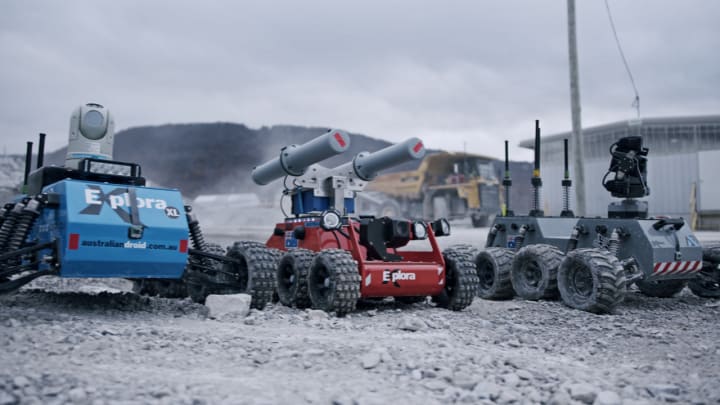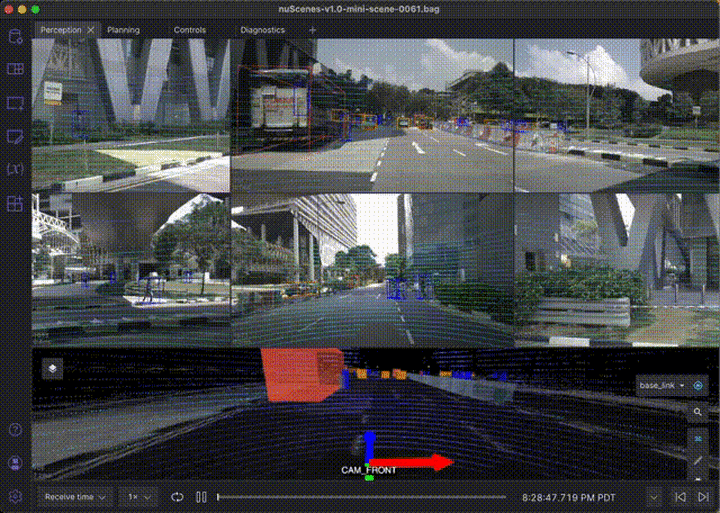Gabriel Aguiar Noury
on 12 February 2022

What a way of starting the year! Setting milestones, helping those in need, and daring to dream. January 2022 starts with one of the biggest technological conferences — CES. So, in this piece, you will find a breakdown of three robots in our usual style. But there’s more… we also bring a story to inspire you all.
It’s a great experience writing this blog, where every month news are abundant. Thank you all for contacting us and sharing your stories.
– How can you share your story??
Simply e-mail us at [email protected] 😉
Security for robotics
Log4j implications and DDS vulnerabilities
Last month we talked about the implications of Log4j for robotics developers. We also presented how new DDS vulnerabilities could become attack vectors for your robot.
This is something we cannot take lightly. So in case you missed it, here you go:
- Check out Canonical’s blog about log4j and instructions for applying all available fixes to your Ubuntu system today.
- Discover the risks on DDS and how to mitigate them in our latest blog.
Malware goes open source
No month of the year is truly vacation time for the security community (you guessed it: not even January). This month saw a new development regarding known malware that could put routers, Internet of Things (IoT), and other connected devices at increased risk.
Last November, security researchers at AT&T Alien Labs detected a dangerous malware written in the open source Go language (quite popular these days among malware developers, as it easily adapts to different platforms and operating systems), which they named “BotenaGo”. It targets routers and IoT devices, and includes exploits for over 30 different vulnerabilities that exist in products from various vendors, including the widely used Linksys, D-Link, and Netgear. To make matters worse, BotenaGo has a very low detection rate by popular anti-malware solutions: fewer than 6 out of the 62 most popular antivirus solutions are able to detect it.
Recently, BotenaGo’s source code was discovered to be publicly available on GitHub. This means that others can reuse the code to develop variants for their own attack campaigns, or just compile it to create and distribute new exploit kits. The malware can be used to gain access to networks and execute remote shell commands on the affected systems. Once inside, attackers can manage lateral movements within the network and reach other systems in the environment.

Check an interactive map tracking the use of libraries with offensive capabilities by threat actors.
As always, you can keep your robots protected from threats by following security best practices. To avoid being a target of known vulnerabilities, apply the latest security updates on your software and hardware promptly. Monitor network traffic and keep an eye out for relevant clues, such as excessive bandwidth consumption, connections from unrecognized IPs, and unusual port usage. The threats won’t stop, but neither does our security awareness.
Robotics in CES 2022
As one of the biggest technological conferences, CES is always a referent for what will come to markets. From early-stage R&D products to final devices, all these products are backed up by a company seeking its commercial success. Today, we put some of the presented robots in our spotlight.
The best innovation — Labrador
No arms, no face, no butler design. This assistive robot’s simple design is one of the main reasons why this robot has one of the best shots at becoming the next Roomba. Labrador is a semi-autonomous mobile table that will support independent living.
There are two things we need to remember. As you age, or physical impairments limit your movement, lifting and moving objects becomes a massive barrier. Secondly, people with this challenge don’t want to lose their independence, who would? They just want the tools to tackle their physical limitations. Labrador is just that. You are getting an intelligent tray/table to help you carry on with your life.

It offers a place to store and transport heavy items that might be difficult to carry or move without help (e.g., water, groceries, books, food, medications). The robot can handle up to 25 pounds (11 kilograms). One version of the robot is at a fixed height, while a slightly more expensive version can raise and lower the height by about one-third of a meter. Labrador uses 3D visual SLAM, combined with depth sensors and bumpers on all sides to navigate through home environments, including low lighting conditions — just like your roomba. On the initial setup, you will need to build a map and set up the “bus stops” where the robot can be sent. This will allow you to speak a destination into a smartphone app or a voice assistant and the robot will make its way there, with zero training time required. Bonus featured? it’ll even charge the user’s small electronics on its lower deck. And while environmental modifications are needed for the robot to bring you items, adding special pallets as shown below is easy. It is also easy to modify these settings.

All in all, Labrador is just brilliant. Think about how houses and people are already adapted to tables and trays. Doors have the right side for them, chairs are meant to be used with them, and the rest of furniture and home appliances also consider them in their design. We use tables every day, so Labrador won’t have any unconscious bias or fear from its users. The learning curve will also be smaller. For assistive robotics, automating everyday objects it’s the way today. Now check its functionality — Labrador is incredibly practical. The company only tried to address one issue — handling objects. They didn’t want to connect people or be an entertainment tool. Unlike many companies that tried to add many features to a single robot, they focused on solving a single challenge. The result is an easy to use, extra pair of hands that lighten the load of everyday tasks in the home. As the co-founder, Mike Dooley, told IEEE-
“We saw usage rates as high as a hundred times a month. All of the pilot users rated the robot highly, and two of them asked if they could invest in the company.”
Which is not surprising.
The robot is in beta release. But we cannot wait to see Labrador helping people.
The “I wish that works!” project – Beyond Honeycomb
Let me dream! Please, let me believe this will be true. Let me fulfil my dream of a high dinner experience in my pyjamas. Beyond Honeycomb came with this bold claim to the CES with its robot chef that claims it can learn new recipes in just 48 hours.
Beyond Honeycomb claims their AI model can recreate the texture and taste from dishes created by master chefs using sensors that acquire the molecular data from the dish while cooking.

“Sensing” the dish to recreate and come up with a recipe is not the only challenge. For a robot to cook, it requires sophisticated control and manipulation system, especially if it wants to achieve a rich range of meals.
Nevertheless, let us fulfil our childhood dreams.

The one that doesn’t need an introduction – Ameca
If this is the first time that you are seeing this robot, you definitely need to follow us on our social media channels. But probably you didn’t know it is running Ubuntu! Ameca has stormed the internet with its unique hyper-realistic facial expressions. Uncanny what? This robot is clearly spooky for some, but it is certainly amusing to see and appreciate its technical complexity to achieve this level of control and motion.
It has only 17 individual motors inside its head controlling its movements and expressions. But still vivid and emotive. While there are movements it cannot do (like the ‘U’ shape), the robot will add more motors in its next iteration.
No, this is not skynet. This is a masterpiece of mechanical engineering and control, and a great company behind it — Engineered Arts.
Reaching a milestone with mine inspecting robots
When accidents hit, robots are also there for us. One of the United States’ largest underground limestone mining operations suffered a pillar and roof collapse. The collapse caused the expulsion of all the air in the mine. A massive gust of air, dirt, and debris flew out of all portals and ventilation shafts at a speed of around 120 mph. Luckily, there were no injuries as the mine was evacuated well before the event as the miners noticed something was wrong.
But the inspection needed to undertake to get governmental approval to start the reconstruction work was blocked. There was no safe way to determine the condition of the mine using traditional manned rescue and recovery techniques. Luckily again, Australian Droid + Robot (ADR) was around. This robotics company specialises in the development of robots for the inspection of inaccessible areas.

Their mobile robots were able to go beyond the collapsed section and inspect autonomously all the required areas, feeding video data at up to 80 Mbps, something unprecedented in mining. The inspection made it possible to re-enter the operation and begin remediation efforts. This is an important milestone for the industry.
No lives should be put in jeopardy anymore. Robots are here to help. Want to read the full story? Find the whole article here.
Open source robotics – white papers
No more self scripts, no more network pain to pass data through. Why is Docker not more simple? Why can my application simply work when I turn on the robot? All the answers are here, in our Docker and ROS whitepaper. This is for all the developers who want to make their work easier.

Open source robotics – video news
Another month, another video. More news, more applications, more robots!
And if you want to feature your robotics application, just send us an email at [email protected].
Open-source robotics – tutorial
Did you say that you want a more difficult challenge? Ok, let’s go for it.
If you are interested in visualising data for production of self-driving cars, here is an in-depth tutorial exploring Motional’s nuscenes dataset inside Foxglove Studio 1.

Stay tuned for more robotics news
As always, we would love to learn from you. Send us a summary of your robotics innovation and project to [email protected], and we will share it in our next robotics newsletter or monthly video. Thanks for reading!



